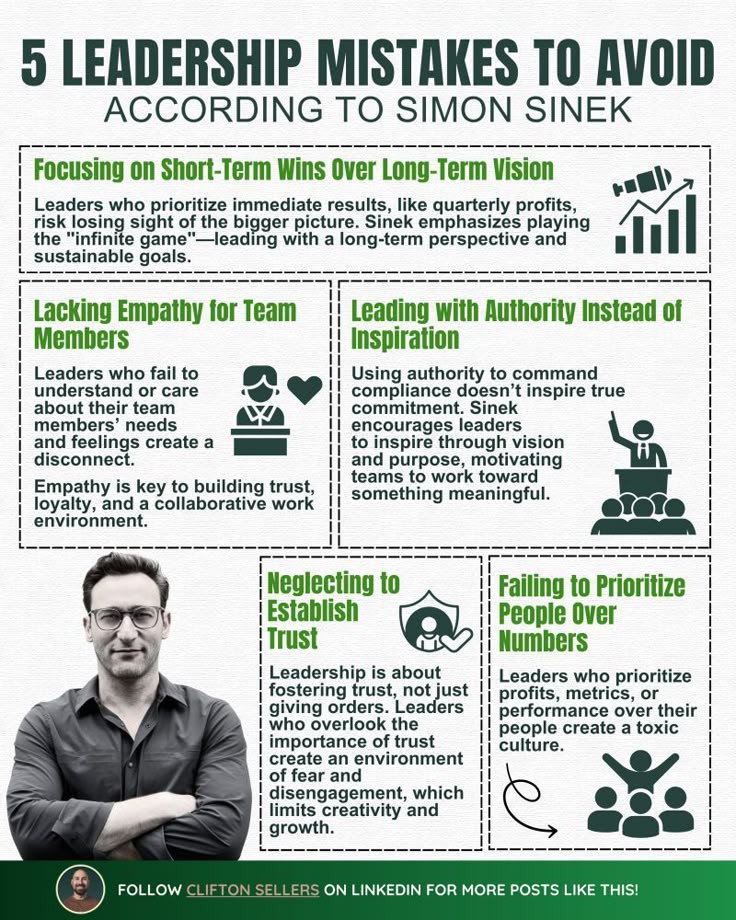
Simon Sinek, a renowned author and motivational speaker, has significantly influenced the way we think about leadership. His insights have helped many leaders understand the importance of fostering a positive work environment and the impact of their decisions on their teams.

While Sinek has shared many valuable lessons, he also emphasizes several leadership mistakes to avoid to ensure effective and inspiring leadership.

One of the primary mistakes Sinek highlights is the focus on short-term results over long-term vision. Many leaders become obsessed with immediate performance metrics, which can lead to a toxic culture of pressure and burnout among employees.

Sinek argues that effective leaders should prioritize a long-term vision that aligns with their organization’s core values. By doing so, they create an environment where employees feel motivated to contribute to a greater purpose, fostering loyalty and commitment.

Another critical mistake is the failure to build trust within the team. Sinek emphasizes that trust is the foundation of any successful organization. When leaders do not prioritize trust-building, they create an atmosphere of fear and insecurity.

Employees may feel hesitant to share their ideas or concerns, leading to a lack of innovation and collaboration. Sinek advises leaders to be transparent, admit their mistakes, and encourage open communication. By demonstrating vulnerability, leaders can foster a culture of trust, where team members feel safe to take risks and share their thoughts.

Sinek also warns against the tendency to prioritize authority over empathy. Many leaders fall into the trap of believing that their title or position grants them the right to dictate decisions without considering their team’s perspectives.

This approach can alienate employees and stifle creativity. Instead, Sinek advocates for empathetic leadership, where leaders actively listen to their team members and consider their input. By valuing the opinions and feelings of others, leaders can create a more inclusive and innovative environment, ultimately leading to better decision-making and team cohesion.

Moreover, Sinek points out the mistake of neglecting employee development. Leaders who fail to invest in their team’s growth may find themselves with disengaged employees who feel stagnant in their roles.

Sinek emphasizes the importance of mentorship and continuous learning, encouraging leaders to provide opportunities for their team members to develop their skills and advance their careers. By fostering a culture of growth, leaders not only enhance their team’s capabilities but also demonstrate their commitment to their employees’ success, which can lead to higher retention rates and job satisfaction.

Lastly, Sinek cautions against the mistake of losing sight of the organization’s “why.” Many leaders become so focused on the “how” and “what” of their operations that they forget to communicate the underlying purpose of their work.

When employees understand the “why” behind their tasks, they are more likely to feel connected to their work and motivated to contribute to the organization’s goals. Sinek encourages leaders to consistently articulate their vision and mission, ensuring that every team member understands their role in achieving the larger purpose.

In conclusion, Simon Sinek’s insights on leadership mistakes serve as valuable guidance for anyone in a leadership position. By avoiding the pitfalls of short-term thinking, lack of trust, authority over empathy, neglecting employee development, and losing sight of the organization’s purpose, leaders can create a thriving, engaged, and motivated workforce.
Embracing these principles not only enhances organizational performance but also fosters a positive and fulfilling work environment for all.






Leave a Reply